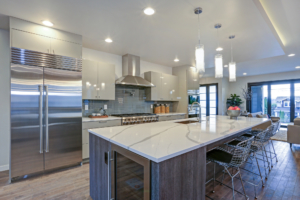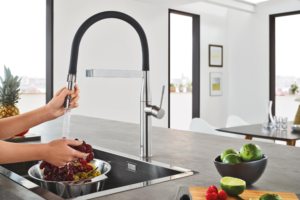Gone are the days of the traditional kitchen work triangle as homeowners alike expand their kitchen needs into multiple work zones.
Before the trend of multiple sinks, double ovens, detached cook tops and hidden appliances, kitchen setups followed the golden rule of what is known as the “work triangle.” Conceived in the late 1940s by the National Kitchen and Bath Association, the work triangle consisted of the path between the refrigerator, cook top and sink to create an ergonomically-friendly workspace.
Devised to keep appliances in close proximity and keep movement to a minimum, the work triangle provided a functional one-cook kitchen environment that was suitable at the time.
Since then, the number of cooks in the kitchen has increased along with the doubling of appliances and even the tripling of tools. To accommodate these growing numbers, the kitchen as we know it has expanded to fit such needs while introducing the idea of multiple work zones as it has become the heart of the home.
“The traditional work triangle has been gone for some time now,” says Steve Johnson, owner of Atelier. “It has, over time, evolved into multiple work triangles throughout the entire kitchen, as it has been that way for some time now.”
Creating multiple workspaces for tasks, such as food preparation, baking, cooking, cleanup and eating, influenced the expansion of kitchen, thus ditching the traditional work triangle concept.
According to Johnson, “this trend makes for a functional space for more people to work in while remaining just as practical when used by one cook.”
Taking this concept of moving away from the traditional and more towards multiple workstations, Marc Desplaines, founder and president of Antoine Proulx, notes, “a kitchen that functions best for its owner is what is important.”
Desplaines’ personal remodel created an open kitchen concept with a clean and streamlined look eliminating upper cabinetry. Choosing to remove the pre-existing work triangle, the remodel created a kitchen with three work zones — preparation, serving and cleanup — allowing up six people to freely move within the multiple workstations.
“It is an excellent example of why a traditional work triangle is not always the best solution,” he says.
When plotting a kitchen remodel, the homeowner should focus on what is necessary and how the space will be used. “Eliminating the work triangle for the sake of a trend doesn’t make sense if the pre-existing space is already working for that user,” Desplaines adds.
However, as our needs increase to accommodate the growing number of cooks, appliances and space desired, incorporating multiple workstations has become a common setup for the contemporary kitchen we have now become accustomed to.
For more information about how you can make the transition from the kitchen work triangle to multiple work zones, visit:
Atelier Inc.
4242 N. Craftsman Court, Scottsdale
(480) 424-7900
scottsdale.poggenpohl.com
Antoine Proulx, LLC
3320 North 44th St., Phoenix
(602) 952-1580
antoineproulx.com



